Physical Address
304 North Cardinal St.
Dorchester Center, MA 02124
The appendix is a vestigial organ without proven significant physiological function; however, it is subject to a host of clinically significant inflammatory disorders, some of which involve the appendix exclusively and others that are systemic.
The vermiform appendix arises from the medial aspect of the cecum, inferior and posterior to the ileocecal orifice. It averages 8 cm long (range 2 to 20 cm) and 0.7 cm in diameter. The appendix is most often located behind the cecum and ascending colon, but it may lie behind the ileum and mesentery, along the pericolic gutter, in the subhepatic region, or in the lesser pelvis. The appendix is maintained in its position by a fold of peritoneum that invests mesoappendiceal fat throughout its length. The appendiceal artery is derived from the ileocolic artery, which is derived from the superior mesenteric artery, and it is located at the free edge of the peritoneal fold.
The appendix is composed of the same five layers as the remainder of the large bowel, consisting of mucosa, submucosa, muscularis propria, subserosa, and serosa ( Fig. 18.1A ). However, in contrast, the mucosa contains abundant, organized lymphoid tissue arranged circumferentially. It closely resembles mucosa from the terminal ileum, particularly in young individuals. The epithelium of the appendix contains goblet cells, absorptive cells, neuroendocrine cells (predominantly Kulchitsky type and basally located), and scattered Paneth cells ( Fig. 18.1B ). Unlike in the colon, in which crypts are uniformly aligned, appendiceal crypts tend to be more irregularly spaced and can be entirely absent in areas of mucosa adjacent to and overlying lymphoid aggregates. In addition to lymphoid tissue, abundant immunoglobulin A (IgA)–secreting plasma cells are also normally present in the lamina propria.
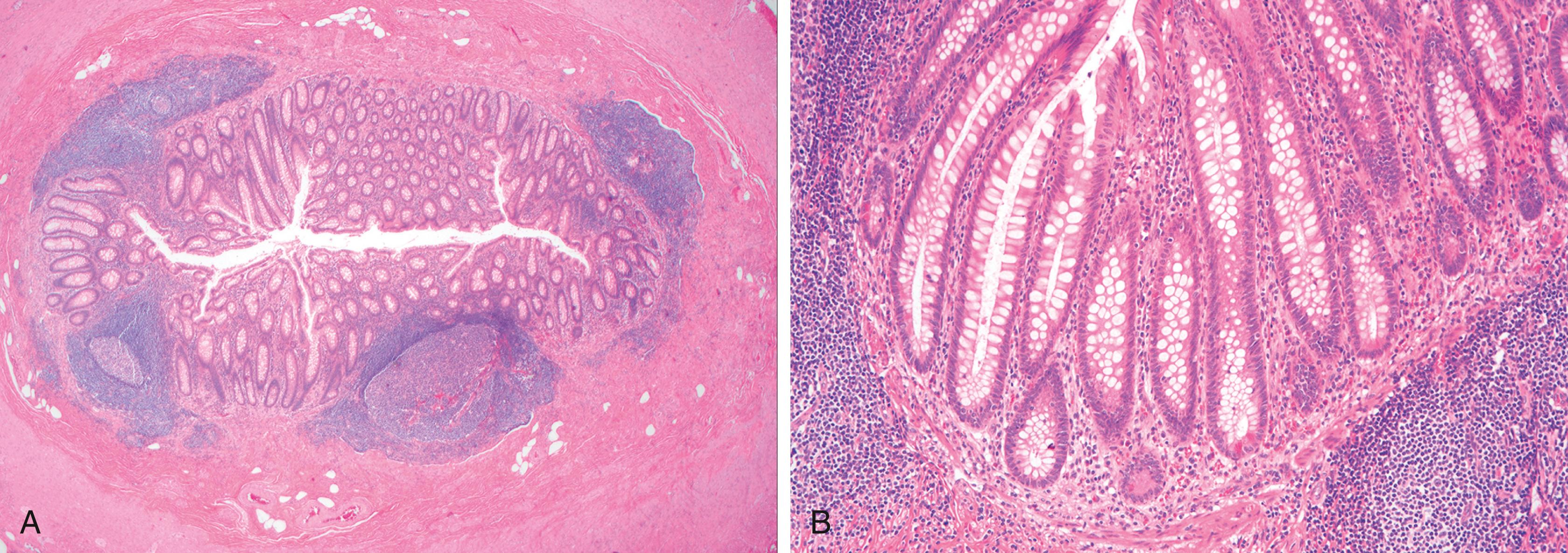
The muscularis propria consists of an inner circular and outer longitudinal layer of smooth muscle, similar to other parts of the gastrointestinal (GI) tract. The appendix is enveloped by serosa up to the point of attachment of the mesoappendix, where the serosa envelops the mesoappendiceal fat up to the peritoneal fold. Under normal circumstances, neutrophils and eosinophils are absent from the mucosa and wall of the appendix.
The appendix may exhibit a variety of anatomic abnormalities, such as an atypical location, duplication, , congenital absence, and luminal septal formation. An abnormally long appendix (>7 to 10 cm) has been linked to the development of torsion, although this complication has also been reported for appendices of normal length.
The position of the appendix is determined mainly by changes in the position and shape of the cecum that occur during organ development, growth, and rotation. If the cecum does not descend fully, the appendix becomes located retroperitoneally in an ascending retrocecal position, anterior to the right kidney. The frequency of a retrocecal location ranges from 26% to 65%. , If the appendix lies in a retrocecal position, it may be positioned intraperitoneally in a paracecal pouch of peritoneum, or retroperitoneally either with or without a paracecal fossa formed by the peritoneum.
The clinical manifestations of acute appendicitis depend on the location of the appendix in the abdomen. If the appendix is located retrocecally, it may give rise to an abscess in the pararenal space, or infection may spread along the right paracolic gutter up to the right posterior subhepatic and right subphrenic spaces. , More than 50% of patients with ascending retrocecal appendicitis have an atypical clinical presentation. They may manifest with right upper quadrant pain or nonlocalizing abdominal pain, instead of the more common presentation consisting of central periumbilical pain followed by localization to the right lower quadrant, signs that are more often seen in cases of classic appendicitis, when the appendix is in its normal anatomic location. , Because of the atypical clinical presentation, retrocecal appendicitis is more likely to be diagnosed later in its course, resulting in a higher incidence of perforation and more serious complications. However, some studies have not shown an association between retrocecal location and perforation at the time of presentation.
Duplication of the vermiform appendix is rare. It is found in approximately 1 of 25,000 patients (0.004%) who have undergone surgery for acute appendicitis. The clinical presentation depends on the location of the appendix in the colon. , Cave and Wallbridge classified appendiceal duplication into three types. , Type A shows incomplete duplication; both appendices have a common base. Type B has complete duplication, with the first appendix arising from its usual location at the confluence of the teniae coli, and the second located at various sites along the colon ( Fig. 18.2 ). Type C has complete duplication of the cecum, with each part having its own appendix. , Duplication of the appendix associated with duplication of the colon has been reported.
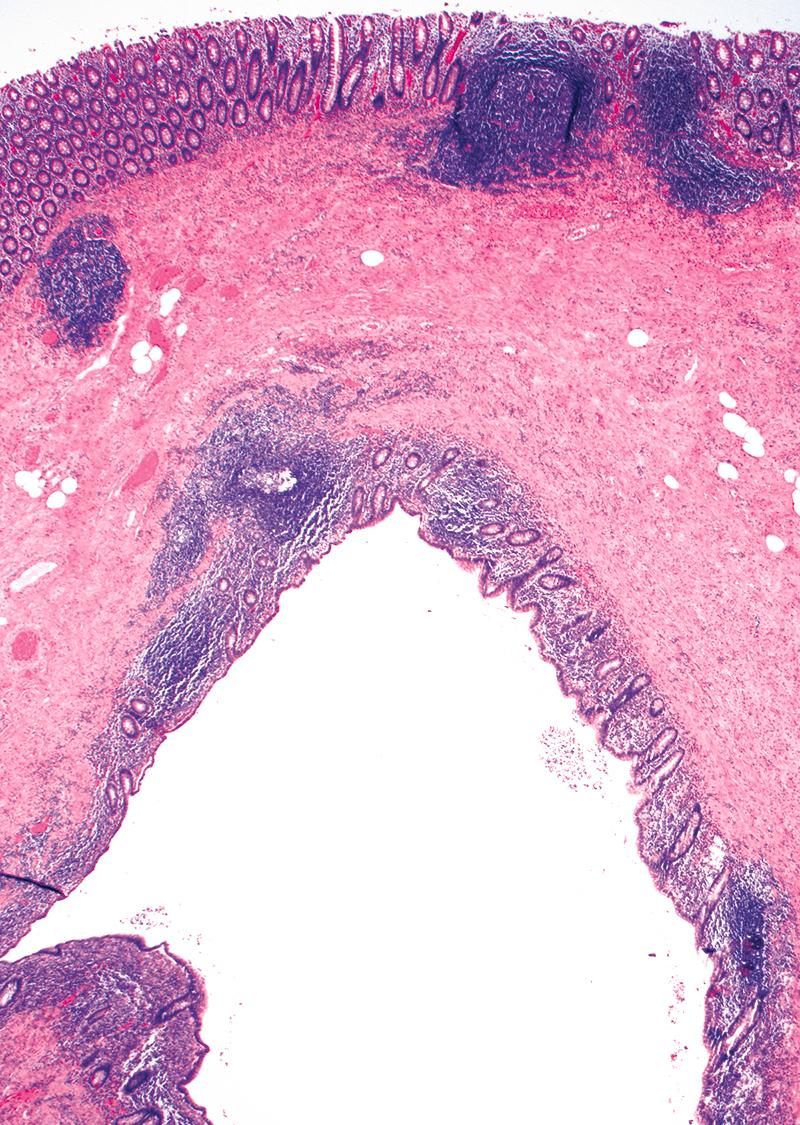
Agenesis and atresia of the vermiform appendix are both quite rare, occurring at an estimated frequency of 1 case per 100,000 resected appendices. , Congenital absence should be diagnosed only after thorough examination of the entire ileocecal region to exclude the possibility of an abnormally located appendix. Congenital absence of the appendix has been associated with other congenital malformations, such as congenital diaphragmatic hernia.
Atresia of the appendix may be associated with atresia of the entire ileocecal region or with atresia of other segments of small intestine. Acute appendicitis may occur in an atretic appendix, but the diagnosis of atresia is usually established only after pathological examination of the resection specimen, because radiological findings are often nonspecific and may be obscured by periappendiceal inflammation.
The appendix can have complete or incomplete septation, a finding that is principally seen in children and young adults, who usually suffer from acute appendicitis at clinical presentation. Possible contributing factors to the formation of septa include congenital abnormality, postinflammatory fusion of mucosal folds, and ischemia caused by thrombosed vessels.
Diverticular disease of the appendix is rare. It has a reported incidence of 1 case (0.77% to 2%) per 50 to 130 appendectomies, or 1 case (0.004%) per 25,000 for true congenital diverticula. , Congenital diverticula are outpouchings formed by all mural layers, including mucosa, submucosa, and muscularis propria. Acquired diverticula presumably result from increased intraluminal pressure and subsequent mucosal herniation through a weak area of the muscularis propria, often at the site of a penetrating artery at the tip of the appendix.
Acquired diverticula occur most often in older males. They are located in the distal third of the appendix, (60%) on the mesenteric border, and usually have a diameter of less than 5 mm ( Fig. 18.3 ). Acquired diverticula may be identified in up to 22% of appendectomy specimens from patients with cystic fibrosis who frequently have appendiceal distension by inspissated secretions ( Fig. 18.4 ).
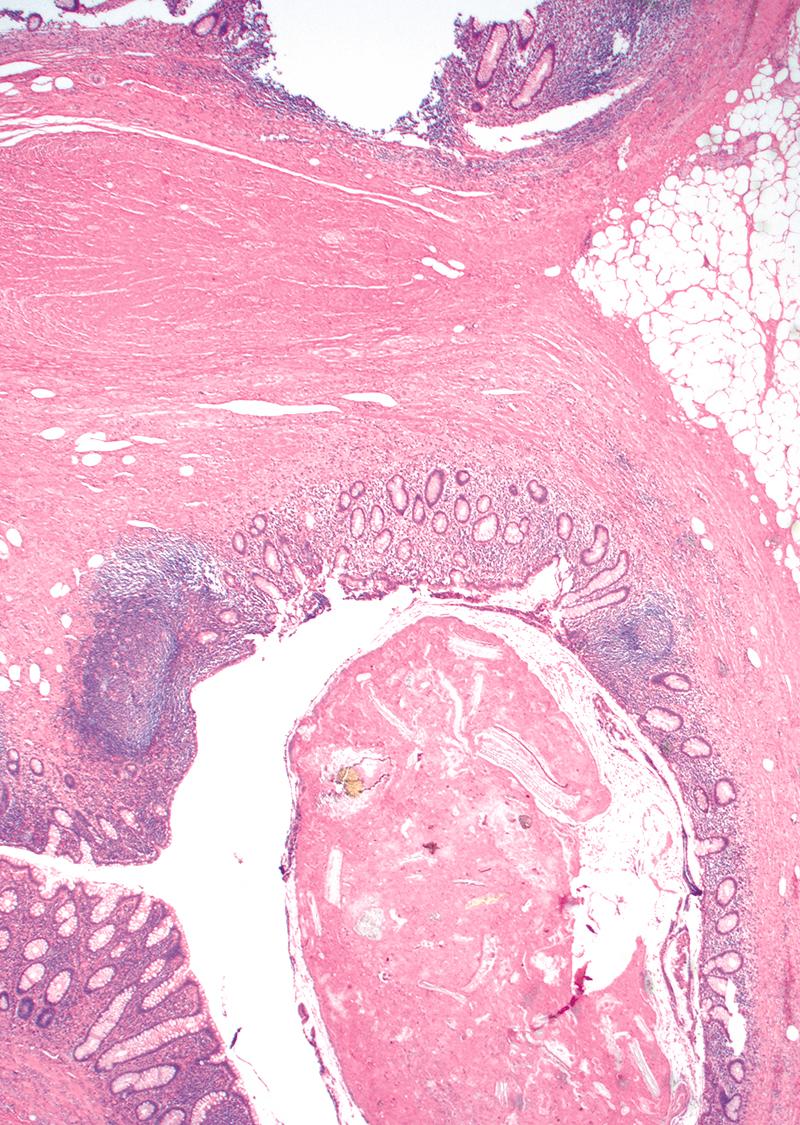
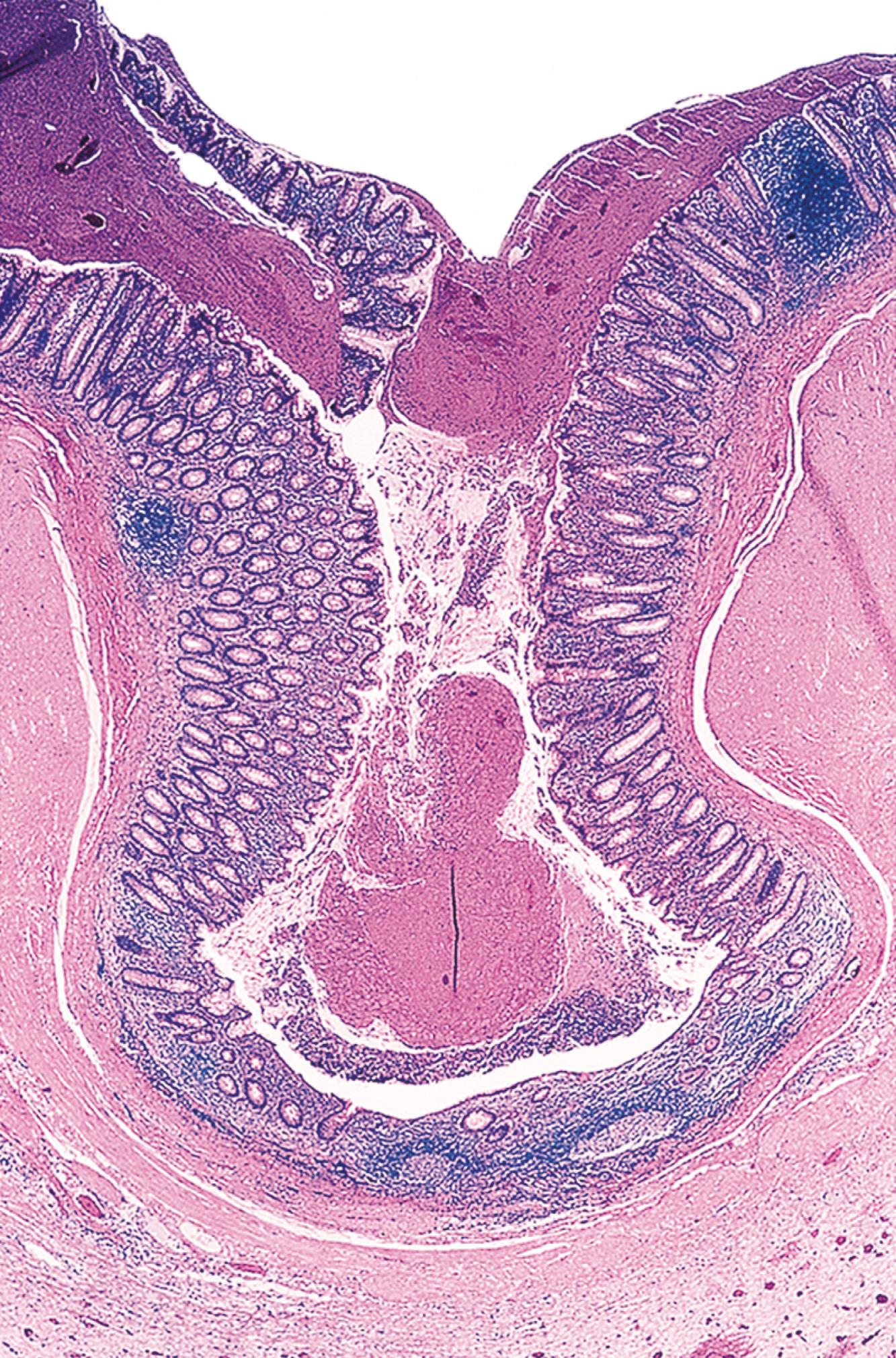
Diverticular disease may be clinically asymptomatic, or manifest with acute or chronic pain, mimicking acute appendicitis. , Computed tomography (CT) may help visualize inflamed diverticula, which appear as small, cystic outpouchings, but there is a high rate of false positives with this method of imaging. During the acute phase of illness, the incidence of perforation is approximately three times higher than that for patients with classic appendicitis (33% versus 10%). Because acquired diverticula lack a muscular wall, perforation is not surprising. The morbidity and mortality rates are greater than those for patients with classic acute appendicitis.
Grossly, the appendix may appear edematous, but diverticula may not necessarily be easily appreciated. If perforation has occurred, the serosa may appear dusky and possess a yellow-tan exudate. Histological findings include an outpouching of appendiceal epithelium through the muscularis propria of the appendix, either with or without associated acute, sometimes suppurative, appendicitis. Chronic changes such as muscular hypertrophy and transmural, periappendiceal fibrosis, and lymphoid atrophy, may be present as well. , In some cases, fibrous obliteration of the lumen may be present. The mucosal lining is essentially that of the normal appendix (see Fig. 18.3 ), but occasionally, superficial hyperplasia and reactive atypia may simulate a neoplasm, particularly low-grade appendiceal mucinous neoplasm (LAMN), as discussed next.
The distinction between hyperplastic or regenerative epithelial changes associated with diverticular disease and LAMN is challenging; examination of the entire appendix is recommended, if necessary, to exclude the possibility of LAMN ( Fig. 18.5 ). Mucosal hyperplasia and regeneration, mural distortion, and rupture with spillage of mucin in diverticular disease all produce striking overlap with mucinous neoplasia. On the other hand, careful study reveals several diagnostically helpful distinguishing features. Mucosal regeneration features superficial gland serration and slight crypt disarray, but overall preservation of the mucosal architecture. The surface displays a smooth contour with evenly spaced crypts, each invested by lamina propria. Some authors note the presence of neuroma-like proliferations in the lamina propria of appendices with diverticulitis. In contrast, LAMNs display a variety of architectural abnormalities. Crowded villous proliferations with filiform projections supported by thin cores of lamina propria are a frequent finding. Areas of LAMN where mucin production causes distention feature completely flat or even extensively denuded epithelial lining with replacement of the lamina propria by fibrosis. Importantly, the epithelial cell composition of reactive hyperplasia is mixed. Although increased goblet cells may be seen in the superficial crypts, hyperplastic proliferations contain a mix of epithelial cell types, including goblet cells, absorptive cells, and Paneth and endocrine cells in the deep crypt regions. The superficial epithelial cells may display reactive atypia, but features of low-grade dysplasia, such as nuclear hyperchromasia, crowding, and elongation are minimal, if present. LAMNs are lined by a monotonous population of columnar epithelial cells with finely vacuolated mucinous cytoplasm, but without discrete mucin vacuoles. Features of low-grade dysplasia are invariably present, although they may be challenging to appreciate in attenuated areas of the neoplasm. Extensive sampling may be necessary to identify the diagnostic findings. The mural changes associated with each of these disorders also overlap. Both produce fibrosis and atrophy of lymphoid tissue. The muscularis propria is often hypertrophic in diverticular disease, whereas LAMN is associated with thinning and fibrous replacement of the muscle. Ruptured diverticula are particularly problematic because they produce changes commonly associated with perforated LAMN. Mucin deposits on the serosa are associated with mixed inflammation, mesothelial hyperplasia, and organizing fibrosis. Detached fragments of diverticular epithelium may be present in the mucin, mimicking localized pseudomyxoma peritonei ( Table 18.1 ). Epithelial cell clusters extruded from ruptured diverticula should display mixed morphology, similar to diverticular lining cells. Efforts should be made to identify diverticula in these challenging cases. Occasionally, they are grossly apparent, but in most cases, they are seen only on microscopic examination. In some instances, communication between the diverticulum and the appendiceal lumen is not seen in the original histological plane of section, but it may become apparent after deeper tissue sectioning.
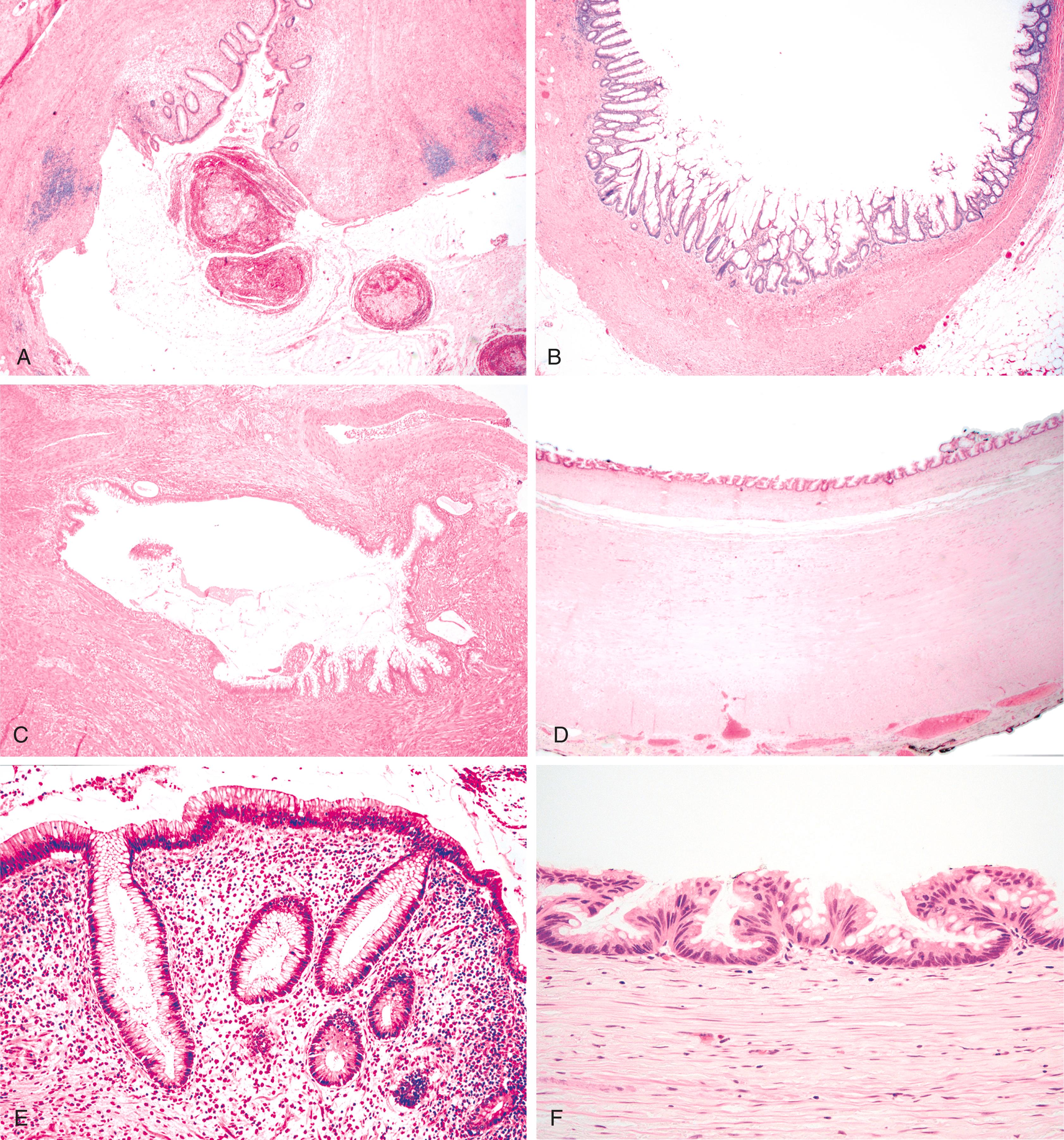
| Feature | Diverticular Disease | Low-Grade Mucinous Appendiceal Neoplasm |
|---|---|---|
| Extraappendiceal mucin | May be present Almost always acellular |
Frequently present May be cellular or acellular |
| Crypt architecture | Preserved, slight variations may be present Even spacing maintained |
Crowded, villiform, minimal intervening lamina propria |
| Epithelial morphology | Bland, reactive hyperplastic changes Mixed epithelial cell types including goblet cells, Paneth cells, endocrine cells Maturation normally present |
Dysplastic, usually low-grade Lack of maturation Monotonous, nongoblet columnar mucinous cells |
| Villiform growth pattern | No | Yes |
| Lamina propria | Present | Usually obliterated by fibrous/hyalinized tissue |
| Acute inflammation | Usually present | May be present or absent |
| Mural fibrosis | Usually present | Usually present |
| Fibrous obliteration | Often present | May be present or absent |
| Muscular hypertrophy | Usually present | Not usually present |
| Diffuse pseudomyxoma peritonei | No | May be present or absent |
Intraluminal pressure generated by mucinous secretions in LAMN may, in fact, produce diverticula ( Fig. 18.6 ). In these cases, the diverticular lining appears similar to the tumor cell population in the native lumen.
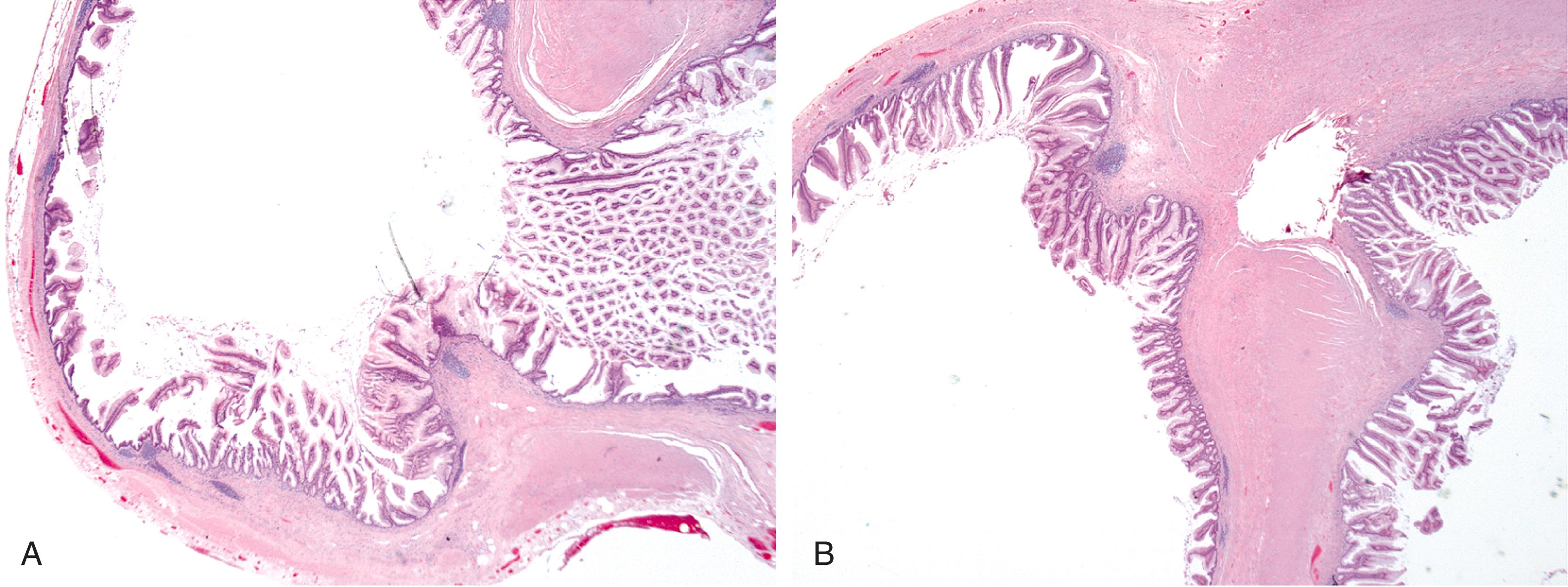
Obliteration of the appendiceal lumen (also known as neuroma or neural hyperplasia) by spindle cells situated within collagenous and myxoid soft tissue is present in approximately one-third of excised appendices. It is usually an incidental finding. The frequency of occurrence increases with patient age.
The tip of the appendix is usually affected, but the whole appendix may be progressively involved. Grossly, the appendix may appear narrow and white in areas of obliteration compared with the adjacent normal appendix. Lesional cells include fibroblasts, Schwann cells, and axons. Admixed mast cells, eosinophils, and scattered endocrine cells may also be present. The infiltrate may be confined to the mucosa, but more commonly, it replaces the entire lumen ( Fig. 18.7 ).
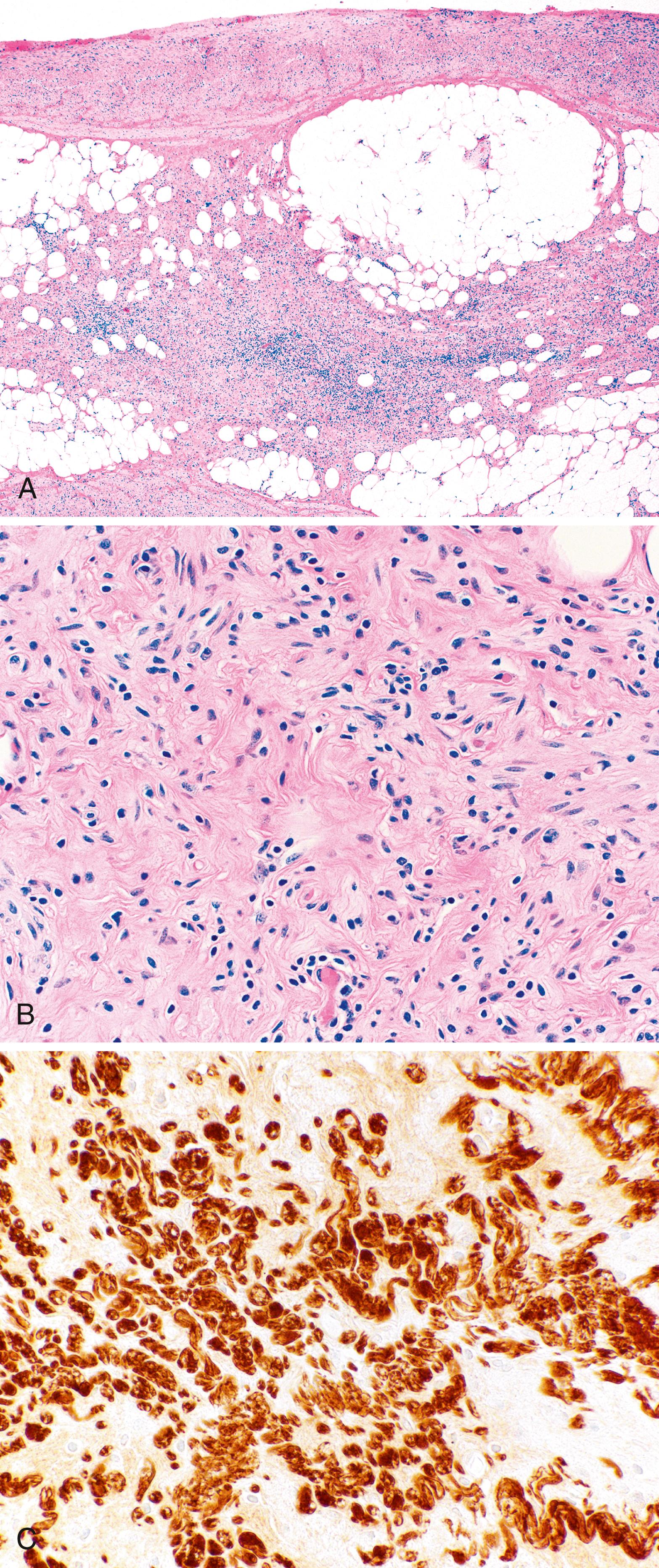
Immunohistochemical staining shows a mixed population of S100 protein–reactive and neuron-specific enolase–reactive spindle cells corresponding to intermingled Schwann cells and axons, respectively. Admixed fibroblasts may be positive for CD34. The finding of lesions with a predominantly neural composition has led to the alternative designation of appendiceal neuroma . This phenomenon is thought to be a reactive process, either as a normal part of aging or as a response to prior acute appendicitis, with progressive phases of growth, involution, and fibrosis. , The common occurrence of fibrous obliteration and neuromatous changes in appendices with ruptured diverticula supports the hypothesis that this phenomenon represents a reactive process.
Acute appendicitis is predominantly a disease of children and young adults. It occurs mainly in children and adolescents between 5 and 15 years of age, although no age group is exempt from this condition. , One crude estimate of the incidence of acute appendicitis in the United States is 11 cases per 10,000 population. Acute appendicitis is more common in Western countries than in Asia or Africa.
The classic symptom triad of acute appendicitis consists of periumbilical pain, which eventually localizes to the right lower quadrant of the abdomen, accompanied by anorexia and nausea. Mild fever, leukocytosis, elevated C-reactive protein level, and right lower quadrant tenderness are usually present. If perforation has occurred, signs of peritonitis may be present. Common clinical mimics of acute appendicitis include mesenteric lymphadenitis (particularly in children), ovarian cysts, appendiceal or colonic diverticulitis, and Meckel’s diverticulitis.
Imaging methods, particularly CT, often used to detect acute appendicitis, have improved recently. , Laparoscopic appendectomy has emerged as a relatively safe operational technique. CT findings suggesting acute appendicitis include distention, wall thickening and enhancement, periappendiceal fat stranding, cecal thickening, and free peritoneal fluid. Approximately 70% of patients suspected of having acute appendicitis by clinical or imaging methods are found to have acute appendicitis at the time of surgery. , Some authorities believe that all appendices, even when grossly normal, should be removed when the indication for surgery was suspected acute appendicitis because almost 20% of all grossly normal-appearing appendices may contain acute inflammation on microscopic examination of the tissue. , One possible exception is for patients who may require urological surgery in the future, because their appendices may prove useful as a potential urinary conduit. Patients with acute appendicitis in the setting of human immunodeficiency virus (HIV) infection have a similar clinical presentation, although sometimes with a less striking elevation in the peripheral white blood cell count. In one surgical series of acute appendicitis in patients with HIV infection, delay before operation increased the likelihood of perforation.
The pathogenesis of acute appendicitis is thought by some to reflect an initial insult to the mucosa resulting from luminal obstruction by a fecalith, a fragment of undigested food, lymphoid hyperplasia, or a tumor, followed by bacterial infection that progressively spreads outward from the mucosa and into and through the wall of the organ. However, the evidence for this mechanism is circumstantial at best. Some authorities believe that acute appendicitis represents one manifestation of a range of injuries that include hypersensitivity reactions, infections, and ischemic lesions. The potential causes of acute appendicitis are listed in Box 18.1 .
Obstruction with superimposed bacterial infection
Fecalith
Lymphoid hyperplasia
Polyp or tumor
Foreign body
Mucin accumulation (e.g., cystic fibrosis)
Infection
Bacterial: Yersinia , Campylobacter
Parasitic: Cryptosporidium , amebiasis
Fungal: Candida , mucormycosis, aspergillosis
Viral: Epstein-Barr virus, cytomegalovirus, varicella-zoster virus, measles virus
Inflammatory bowel disease
Ulcerative colitis
Crohn’s disease
Diverticular disease
Stump appendicitis (after appendectomy)
The appendix may appear grossly normal when inflammation is limited to the mucosa and submucosa. However, when inflammation extends into the muscularis propria, the appendix frequently becomes swollen and erythematous, due in part to dilation of the serosal vessels. When the serosa is affected, the peritoneum is initially dull and gray, but then a purulent exudate may develop. In approximately one-third of cases, a fecalith is identified. Perforation from mural necrosis (i.e., “gangrenous” appendicitis) can follow, which may eventually lead to abscess formation. Sometimes, an appendix resected in the clinical setting of acute appendicitis is grossly and histologically normal, even after submission of the complete specimen for histological examination. In these cases, a specific cause is rarely found. Other possible causes are listed in Box 18.2 .
Yersinia ileitis or mesenteric adenitis
Spirochetosis
Cystic fibrosis
Other intraabdominal disease (e.g., endometriosis)
On microscopic examination, early changes include mucosal erosions and a neutrophilic infiltrate resulting in cryptitis and crypt abscesses ( Fig. 18.8 ). Later, the inflammation extends into the submucosa and muscularis propria. Collections of neutrophils may be seen in the lumen as well. However, luminal neutrophils alone are not sufficient for a diagnosis of acute appendicitis but raise suspicion of its presence. When inflammation extensively damages the muscularis propria, mural necrosis can lead to perforation. Thrombosed vessels may be present. When the interval between symptom onset and surgery exceeds 72 hours, mural eosinophils may be the predominant inflammatory cell type. When periappendiceal inflammation occurs in the absence of mural involvement, other causes of peritonitis should be sought clinically (see “Periappendicitis”). Anaerobic bacteria are detected in approximately 50% of cases, but they may represent secondary colonization rather than being the primary cause of the acute appendicitis.
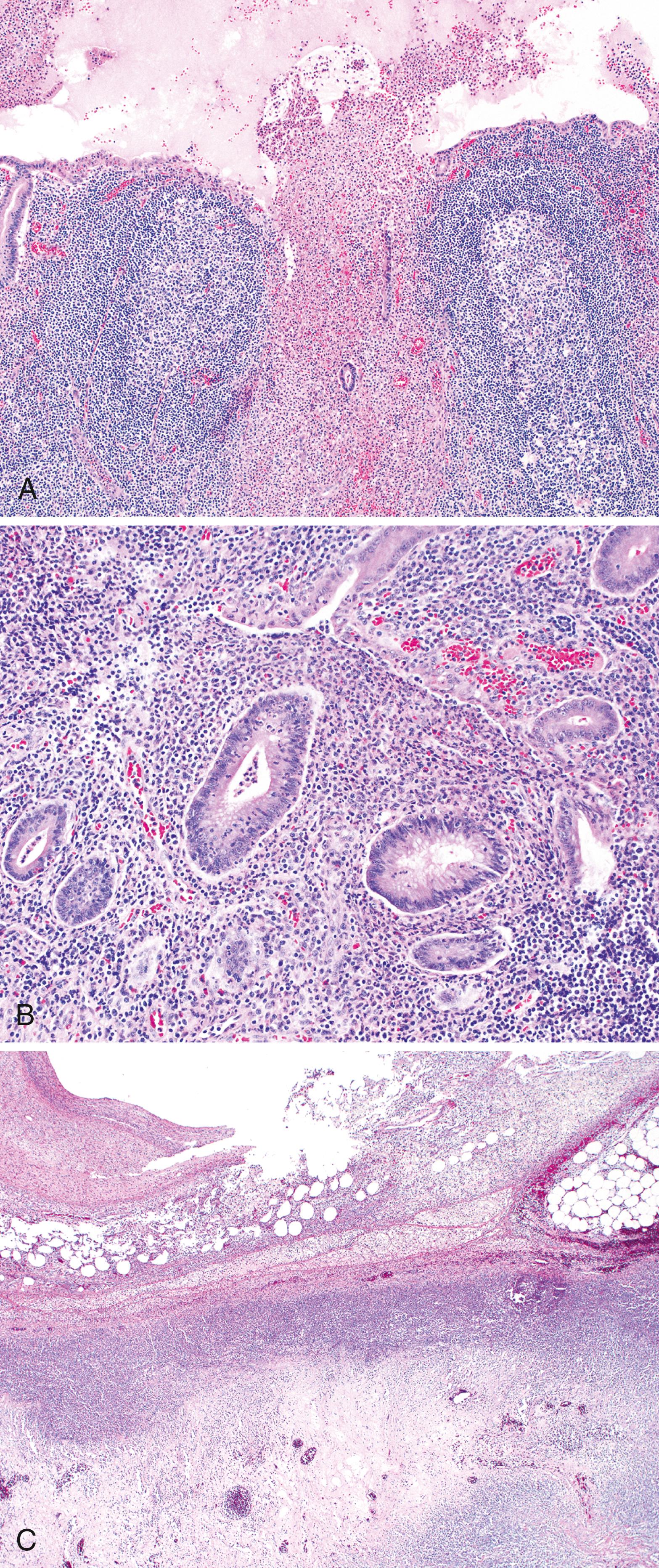
The morphological differential diagnosis, at least for very early appendicitis, includes, among others, infectious gastroenteritis, inflammatory bowel disease (IBD) involving the appendix, and trauma from fecaliths, all of which may result in “mild” superficial neutrophilic inflammation. If inflammation is limited to the mucosa, additional sections may reveal mural inflammation, which would support a diagnosis of primary acute appendicitis. The differential diagnosis with IBD involving the appendix is discussed further below.
Two general and basic patterns of disease progression may occur in patients with acute appendicitis. , In the first and more common pattern, there is a mixed inflammatory infiltrate ranging from patchy and mild in the early phase, to diffuse and transmural in later phases. In some appendices, there may be intramural or serosal foreign body–type giant cells surrounded by granulation tissue, suggesting prior rupture. Serositis, fibrous adhesions, and prominent submucosal fibrosis can occur. Mucin extravasation is often present as well. A second, more chronic, pattern, which has been termed xanthogranulomatous appendicitis , consists of an infiltrate of foam cells and multinucleate histiocytes, with hemosiderin deposition, luminal obliteration, and sparing of lymphoid follicles ( Fig. 18.9 ). This reaction pattern shares features with Crohn’s disease (CD), but lacks epithelioid granulomas, has fewer lymphoid aggregates, and shows less subserosal fibrosis. However, in one study, a patient exhibiting this pattern of inflammation was found to have CD on follow-up, so the features of these two conditions do overlap. Clinical correlation, and determination of disease elsewhere in the small or large bowel, and anus, is important in such cases.

The most common complications of acute appendicitis are perforation, with the development of peritonitis and abscess formation. Young children and elderly adults have the highest risk of perforation. For some patients in whom the appendix has already ruptured at the time of presentation, the surgeon may elect to treat the condition initially with antibiotics and drainage, followed by an appendectomy 4 to 8 weeks later. This approach is termed an interval appendectomy (see “Chronic Appendicitis”).
Periappendiceal abscesses may result in an inflammatory mass that mimics a neoplasm clinically. If not surgically treated, an abscess may fistulize into the small intestine or colon or onto the skin surface. In women, obstruction of an adjacent fallopian tube may lead to infertility. Inflammation of adjacent blood vessels may result in pylephlebitis. Early diagnosis and surgical intervention (i.e., appendectomy), combined with antibiotic therapy, has drastically reduced the mortality rate associated with acute appendicitis since the early 1900s. The mortality rate for acute appendicitis is now less than 0.5%.
Stump appendicitis represents an uncommon late complication of appendectomy. It is defined as residual or progressive acute inflammation in the remaining stump of the appendix after surgery. A diagnosis of stump appendicitis is often delayed primarily because of its relatively infrequent occurrence, but a high level of suspicion should be maintained for patients who have signs and symptoms of appendicitis after appendicectomy. A history of colicky central abdominal pain that localizes to the right lower quadrant does not often occur in patients with stump appendicitis. Other signs and symptoms include generalized abdominal pain and tenderness, nausea, vomiting, fever, and peritonitis. Abdominal CT findings that reveal a distended appendicular stump, fecalith, pericecal fat stranding, or abscess help to confirm the diagnosis. The consequences of delayed diagnosis include stump necrosis, gangrene, and perforation, which occur in as many as 40% of patients.
Pathological features of stump appendicitis have not been fully described. However, in most cases, findings are similar to those of classic acute appendicitis, consisting of neutrophils, cryptitis, and some degree of transmural inflammation. Transmural necrosis and perforation can occur in patients with late-stage disease. Granulomatous inflammation has been described in one patient with stump appendicitis.
Management usually requires surgical resection of the inflamed residual appendix and antibiotic therapy. It is unclear whether the increasing use of laparoscopic instruments for appendectomy is associated with an increase in the incidence of stump appendicitis.
Periappendicitis without mucosal or mural involvement occurs in 1% to 5% of appendices resected for clinically suspected acute appendicitis. Most cases are caused by salpingitis, often in the setting of chlamydia (pelvic inflammatory disease). Other well-described causes include yersiniosis, Meckel’s diverticulitis and associated intraperitoneal abscess, urological disorders, colonic neoplasms, infectious colitis, abdominal aortic aneurysm, bacterial peritonitis, and GI perforation. , The clinical presentation differs somewhat from that of classic acute appendicitis, including longer duration of pain, localization less often in the right lower quadrant, and fewer peritoneal signs.
Grossly, the serosal surface of the appendix and mesoappendix may appear dull and coated with a fibrinous exudate. Preoperative mechanical manipulation of the appendix may cause mild, diffuse neutrophilic infiltration of the periappendiceal serosa. However, when inflammation in the serosa is accompanied by fibrin deposition or adhesions, it is a potentially significant clinical finding.
Microscopically, a neutrophilic infiltrate is seen within the serosa. The inflammation may extend into the subserosa and rarely into the muscularis propria. Fibrinous adhesions may also be identified. By definition, the mucosa of the appendix is uninvolved. Because the serosal findings are common in patients with acute appendicitis, examination of the entire appendix is recommended to exclude this diagnosis completely. The management of periappendicitis depends on the underlying cause.
The criteria and definition of “chronic appendicitis” as a discrete clinical or pathological disease entity are controversial. For instance, the term chronic appendicitis has been used to describe fibrous replacement of the appendiceal wall after severe or recurrent bouts of acute appendicitis. This process also has been referred to clinically as subacute appendicitis . The term has also been used for patients who have had an interval appendectomy, when resection of a perforated appendix was delayed as a result of initial conservative management with antibiotics and drainage. This entity is discussed further later. Thus “chronic appendicitis” is an umbrella diagnosis that encompasses any type of potentially chronic inflammatory condition of the appendix, other than classic acute appendicitis.
Recurrent episodes of acute appendicitis (i.e., subacute appendicitis), ulcerative colitis (UC) and CD of the appendix, granulomatous appendicitis (and its many causes), and cystic fibrosis are also potential causes of chronic appendicitis. The causes of chronic appendicitis are summarized in Box 18.3 . Features of disorders classified under this term are detailed next and in Table 18.2 .
Inflammatory bowel disease
Ulcerative colitis
Crohn’s disease
Interval appendicitis
Diverticular disease
Sarcoidosis
Idiopathic granulomatous appendicitis
Infection
Bacterial: Yersinia , tuberculosis
Parasitic: schistosomiasis, strongyloidiasis
Fungal: Candida, Histoplasma
Malakoplakia
Cystic fibrosis
| Disorder | Clinical Findings | Distribution | Gross Findings | Histological Findings |
|---|---|---|---|---|
| Ulcerative colitis | Chronic colitis with continuous involvement of the distal colorectum | Appendix may be involved by pancolitis or a “skip lesion” | Mucosal erythema and ulceration | Features of chronic active colitis: cryptitis, crypt abscesses, lymphoplasmacytosis, architectural distortion, Paneth cell hyperplasia |
| Noninfectious granulomatous appendicitis | ||||
| Crohn’s disease | Intestinal and extraintestinal manifestations of inflammatory bowel disease | Patchy enterocolitis, not confined to the appendix | Thickening, adhesions, fistulization to adjacent structures | Transmural inflammation, lymphoid hyperplasia nonnecrotic epithelioid granulomata, neural hypertrophy |
| Interval appendicitis | Mirrors acute appendicitis: adolescents, young adults History of acute appendicitis and delayed appendectomy |
Limited to the appendix, localized peritonitis if perforated | Edematous, hyperemic appendix, hemorrhagic contents, fecaliths | Fibrosis, lymphoid hyperplasia, granulomas centered on lymphoid follicles, xanthogranulomatous inflammation |
| Sarcoidosis | African American patients, 3rd-5th decade Hilar lymphadenopathy, pulmonary and other systemic involvement, elevated serum angiotensin converting enzyme |
Systemic disease, affects lung, heart, central nervous system, skin | Fibrosis, may have superimposed acute appendicitis | Nonnecrotic epithelioid granulomata involve all layers of the appendix, may have transmural lymphoid aggregates |
| Infectious appendicitis with chronic clinical course | ||||
| Actinomycosis | Young adults and children | Often confined to appendix, may involve right colon | Markedly enlarged and indurated, adhesions to other intraabdominal structures | Transmural inflammation, lymphoid hyperplasia, granulomas surrounded by neutrophils, “sulfur granules,” Splendore-Hoeppli phenomenon, filamentous organisms are gram positive and can be identified with GMS stains |
| Yersiniosis | Infants, children, young adults, more common in cooler climates | Ileocecal region, appendix, mesenteric lymph nodes | Nodular inflammatory masses, ulcers, perforation | Acute appendicitis with suppurative epithelioid granulomata |
| Tuberculosis | Immunocompromised, more common in endemic regions and developing countries | Ileocecal, mesenteric lymph nodes | Mural thickening and serosal adhesions | Lymphoid hyperplasia, centrally necrotic confluent granulomas Scarce organism may be seen in AFB stains |
| Strongyloidiasis | Chronically ill or immunocompromised patients, particularly in tropical climates | Affects multiple organ systems, may be present throughout the GI tract | Edematous and hyperemic appendix | Transmural eosinophil and neutrophil-rich inflammation, larvae in crypts are curved with pointed tails, occasional granulomas |
| Schistosomiasis | Preferentially affects children, particularly in tropical and developing countries | Affects multiple organ systems, especially the GI and genitourinary tracts | Edematous and hyperemic appendix, may show fibrosis | Transmural eosinophil rich inflammation with granulomatous reaction to ova, ova are ovoid and often calcified |
The appendix plays an interesting, but poorly defined, role in patients with UC or CD. For instance, appendectomy is a protective factor in UC. The prevalence of prior appendectomy is lower among patients with UC compared with the general population.
Appendicitis, which is usually ulcerating in patients with UC, is typically seen in patients with pancolitis, but it may also occur as a “skip lesion” in patients with subtotal, left-sided, or rectal-only disease. It has an overall incidence of 50% among patients with UC.
Grossly, erythema and ulceration at the appendiceal orifice may be seen endoscopically. Ulcerative appendicitis shows histological features similar to those of the colon in UC (see Chapter 17 ). Active mucosal inflammation is characterized by cryptitis, crypt abscesses, and suppurative luminal exudate. Chronic changes include lamina propria lymphoplasmacytosis, basal lymphoid aggregates, crypt architectural distortion, and Paneth cell hyperplasia ( Fig. 18.10 ). Early acute appendicitis in non-UC patients exhibits less crypt distortion and plasmacytosis than in UC-associated appendicitis. In UC, immunostains may show prominent S100 protein–reactive and MAC387-positive dendritic cells, which are not present in non-UC cases of acute appendicitis. The prognostic implication of appendiceal involvement in UC is dictated by the degree and extent of colonic involvement, but there are little outcome data in this regard.

Unlike for UC, the relationship between appendectomy and CD is not well established. However, one study did find a protective effect of appendectomy on the occurrence of disease after the bias of appendectomy at the time of diagnosis of CD was removed from the analysis. Most appendices removed from patients with CD of the small and large intestine are histologically normal. Patients with appendiceal involvement in CD usually have extensive ileocolonic involvement. Many cases labeled granulomatous appendicitis in the past were thought to represent CD. However, more recently this entity has proved to represent a variety of different disorders, all of which feature granulomatous inflammation in the appendix. A crude estimate of the incidence of appendiceal involvement in CD from the recent literature is approximately 20%.
In patients with appendiceal involvement, the histological features are similar to those seen in other sites of the GI tract. Mucosal ulceration, active inflammation with cryptitis and crypt abscesses, granulomas, transmural inflammation, transmural lymphoid aggregates, fissures, and fistulas are characteristic features. Paneth cell hyperplasia may also occur. Scattered nonnecrotizing granulomas are identified in approximately 50% to 80% of cases ( Fig. 18.11 ). , Occasionally, focal necrosis may be seen within the granulomas. Many of these findings may also be seen in patients with idiopathic granulomatous appendicitis (discussed later), and at initial presentation, the distinction between the two entities may be impossible in the absence of a history of CD elsewhere in the GI tract. Patients with appendiceal CD usually have extensive ileocolic involvement, and the prognosis depends on the degree of extraappendiceal involvement.

Granulomatous appendicitis is an uncommon finding in appendectomy specimens. It is identified in less than 1% of cases. Historically, most cases of granulomatous appendicitis were thought to result from involvement of the appendix by CD, but more recent data suggest that this is true in only 5% to 10% of cases. Other potential causes of granulomatous appendicitis are summarized in Box 18.4 . They include primary (i.e., idiopathic granulomatous appendicitis) and secondary causes such as interval appendicitis, sarcoidosis, foreign body reactions, and infectious disorders (e.g., Yersinia , tuberculosis, actinomycosis, schistosomiasis, strongyloidiasis, Enterobius vermicularis , Candida , Histoplasma ), among others.
Interval appendicitis
Crohn’s disease
Idiopathic granulomatous appendicitis
Sarcoidosis
Infection
Bacterial: Yersinia , tuberculosis, actinomycosis
Parasitic: schistosomiasis, strongyloidiasis
Fungal: Candida, Histoplasma
Foreign body reaction: talc, prior intraabdominal procedures
Clinically, patients with granulomatous appendicitis may reveal symptoms that mimic acute suppurative appendicitis or symptoms related to the underlying disease. In some cases, it may be entirely asymptomatic, in which case the finding of granulomatous appendicitis is made in appendectomy specimens that were removed for non–appendix-related disorders.
Depending on the cause, the size of the appendix may be normal or enlarged. There also may be serosal exudates or fibrous adhesions. Granulomas, which are composed of histiocytes surrounded by a cuff of lymphocytes, may contain multinucleate giant cells, and they may be necrotizing or nonnecrotizing ( Fig. 18.12 ). Necrosis is most commonly seen in infectious disorders, but occasionally granulomas in sarcoidosis and CD may have focal necrosis. Granulomas may involve any layer of the appendiceal wall. The crypt architecture may be distorted. Cryptitis or crypt abscesses may also occur. Yersinia and tuberculosis-associated cases are also associated with transmural inflammation and lymphoid hyperplasia and thus mimic CD.

Management of granulomatous appendicitis depends on the underlying cause. Idiopathic granulomatous appendicitis, sarcoidosis, and infectious causes of granulomatous appendicitis are discussed in later sections. Distinguishing features of the principal causes of granulomatous appendicitis are summarized in Table 18.3 .
| Feature | Crohn’s Disease | Idiopathic Granulomatous Appendicitis | Interval Appendicitis | Sarcoidosis | Tuberculosis | Yersiniosis |
|---|---|---|---|---|---|---|
| Relevant clinical history | With or without known Crohn’s disease | None | Acute appendicitis | With or without known sarcoidosis | Compromised immune system | Young age |
| Disease distribution | Ileocecal involvement | Limited to the appendix | Limited to the appendix | Systemic, involves mediastinum, liver, central nervous system | Pulmonary and ileocecal involvement | May or may not involve ileocecal region, mesenteric lymphadenopathy |
| Granulomas | Occasional | Numerous | Occasional (variable) | Numerous | Numerous | Numerous |
| Distribution of granulomas | Scattered | All layers | Centered on lymphoid follicles | All layers | Concentrated in submucosa | Centered on lymphoid follicles or in the appendiceal wall |
| Other features of granulomas | Small, epithelioid, lack necrosis | Epithelioid, lack necrosis | Epithelioid, lack necrosis, Xanthogranulomatous inflammation also present |
Epithelioid, lack necrosis | Large and confluent with central necrosis | Central necrosis or suppurative inflammation, lymphoid cuff |
| Active inflammation | Yes | Yes | Variable | Uncommon (mild) | Yes | Variable |
| Fissures, fistulas | Yes | Occasional | Rarely | No | No | No |
| Transmural lymphoid aggregates | Yes | Yes | Occasionally | Uncommon | No | No |
| Fibrosis | Yes | Yes | Yes | Yes | Mild, variable | Mild, variable |
Idiopathic granulomatous appendicitis is defined as a primary granulomatous inflammatory disorder of the appendix of unknown origin. It shows a predilection for young adults who present with acute or subacute lower abdominal pain, although some are entirely asymptomatic.
Most cases historically classified as idiopathic granulomatous appendicitis are probably attributable to infectious causes (e.g., Yersinia spp.), interval appendicitis, or other identifiable causes of granulomatous inflammation (e.g., sarcoidosis). True idiopathic granulomatous appendicitis is quite rare, occurring in <0.01% of appendectomy specimens.
By definition, idiopathic granulomatous appendicitis can only be diagnosed in patients without a history of CD. Also by definition, it is characterized by multiple granulomas, usually nonnecrotizing, involving any, or all, layers of the appendiceal wall. Associated histological findings include a variety of acute changes such as neutrophilic infiltration resulting in cryptitis, crypt abscesses, mucosal erosion, and ulceration. Chronic changes include fissures, transmural lymphoid aggregates, and mural fibrosis.
Become a Clinical Tree membership for Full access and enjoy Unlimited articles
If you are a member. Log in here